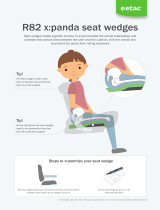
20
Butterfl y harness
The butterfl y harness provides
anterior support while allowing
maximum freedom of movement.
To install butterfl y harness insert L-shaped
metal clips (A) at the ends of lower harness
straps into slots (B) at either side of seat.
Press clip fi rmly into slot with back of
L-shape towards front of seat, making sure
it clicks into place and holds when pulled.
Then clip top buckles (D) together behind
top of backrest (see Figure 19a).
To remove butterfl y harness, use pen to
depress small white button (C) and pull
harness upwards to disengage clip. Repeat
on other side of seat (see Figure 19a).
To use butterfl y harness, unclip all four
buckles (D) to completely free harness pad
(see Figures 19a and 19b). Transfer user
into chair, then place harness pad on user’s
chest. Secure all four buckles and adjust
straps as necessary.
Note: The butterfl y harness can be
clipped into either set of small slots at
sides of chair. Use other set of small
slots for seatbelt or pelvic harness.
WARNING
ALWAYS use a seatbelt or pelvic
harness. Absence of a seatbelt or pelvic
harness may result in falls and may
pose a strangulation hazard to user
when a chest strap, butterfl y harness or
tray is in use.
ALWAYS check fi t of butterfl y harness,
especially after adjusting chair. Loose
straps, over-tightened straps, or
wrongly positioned harness pads may
pose a strangulation hazard to user
(see below).
Absence of lateral supports may
cause top of butterfl y harness to exert
enough pressure on one side of user’s
neck to pose a strangulation hazard.
Figure 19a
Harness Pad
Figure 19b
A
B
C
D
D
























